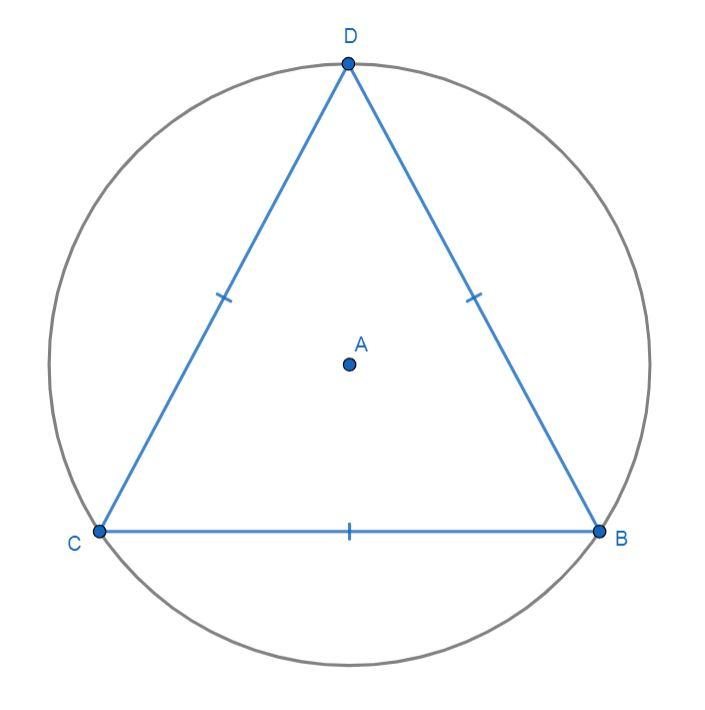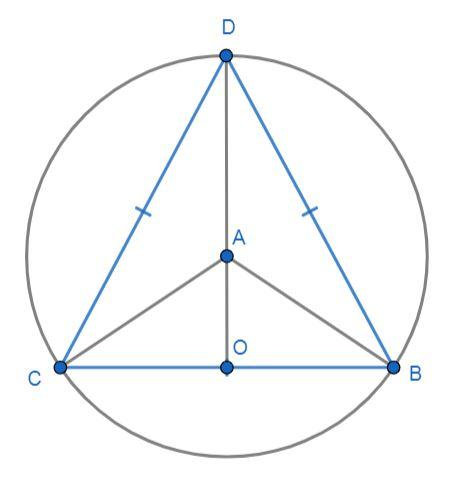Question
Question: An equilateral triangle of side \(9\) cm is inscribed in a circle. Find the radius of the circle....
An equilateral triangle of side 9 cm is inscribed in a circle. Find the radius of the circle.
Solution
First use the property of the equilateral triangle after constructing an altitude from the vertex D on the side BC. After that use the property of the subtended angle by an arc to get the desired result.
Complete step by step solution:
We have given an equilateral triangle of side 9 cm inscribed in a circle.
The goal is to find the radius of the circle.
Now, draw a figure in which an equilateral triangle of side 9 cm is inscribed in a circle. Then the figure is given as:

In the above figure, BCD is an equilateral triangle which is inscribed in a circle whose center is A.
Since ABC is an equilateral triangle, then the altitude from its vertex to the corresponding side is the perpendicular bisector of the side even if it passes through the circumcenter of the triangle.
Now, for starting the problem we have made some construction. So, draw an altitude from the vertex D on the side BC at the point O, then the above figure becomes:

Now, take a look on the triangles AOC and AOB,
OC=OB(D is the mid-point of BC)
AB=AC(Radius of the circle)
AO=AO(Common side of the triangle)
Therefore, using the SSS rule of the congruency, we can say that the triangles AOC and AOB are congruent. That is
ΔAOC≅ΔAOB
Then we have,
∠CAO=∠BAO
We know that the angle subtended by an arc at the center is double the angle subtended by it at any point on the remaining part of the circle. Then we can write,
∠CAB=2∠CDB
As ΔBCD is an equilateral triangle, then each of its angles has a measure of 60∘, thus
∠CDB=60∘
Using it we have,
∠CAB=2×60∘=120∘
Now, we can easily, break the angle ∠CAB in the sum of two angles as:
∠CAB=∠CAO+∠BAO
As we have∠CAO=∠BAO, then
∠CAB=∠CAO+∠CAO
∠CAB=2∠CAO
∠CAO=21(∠CAB)
Substitute the value ∠CAB=120∘ into the equation:
∠CAO=21(120∘)
∠CAO=60∘
As the altitude from the vertex D on the side, bisect the side BC, then
CO=21(CB)
Substitute the length of a side, BC=9 into the equation:
CO=21(9)=29
Now, in the triangle CAO, we have
∠CAO=60∘andCO=29
Now, apply the trigonometric ratio in the triangle CAO, we have
sinA=CACO
Substitute the values:
sin60∘=CA29
⇒23=2CA9
Solve the equation for CA,
CA=39×33
⇒CA=33cm
Therefore, the radius of the circle is 33cm.
Note: The altitude drawn from the vertex on the side is perpendicular to the side and bisect it and also the altitude passes through the circumcenter of the triangle.
